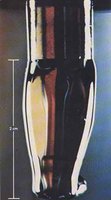Indium

| Topics: |
Geology (main)
|
Contents
Background
Indium is a soft, silver-white metallic element. Its atomic number is 49 and its chemical symbol is In. Indium was discovered in 1863 by the German chemists Ferdinand Reich and Heironymous Richter. They not only discovered this element, but also were the first to isolate pure indium. It was at first believed to be very rare. It is now known that it is relatively abundant in some but not all zinc sulphide (sphalerite or ZnS) ore deposits. Indium is very stable in both air and water; it does react with some acids. It forms only a very few rare minerals, such as indite, which is never abundant enough to be an ore of indium.
Indium has the unusual physical property that when it is bent (that is, when it is stressed) it creates a sound similar in pitch to a scream.
Indium is not necessary for any biological purpose. It has been shown that small amounts of indium cause an increase in metabolism.
Name
| Previous Element: Cadmium Next Element: Tin |
| |
| Physical Properties | ||
|---|---|---|
| Color | silvery-white | |
| Phase at Room Temp. | solid | |
| Density (g/cm3) | 7.31 | |
| Hardness (Mohs) | 1.2 | |
|
Melting Point (K) |
429.81 | |
|
Boiling Point (K) |
2353 | |
| Heat of Fusion (kJ/mol) | 3.3 | |
| Heat of Vaporization (kJ/mol) | 232 | |
| Heat of Atomization (kJ/mol) | 243 | |
| Thermal Conductivity (J/m sec K) | 81.8 | |
| Electrical Conductivity (1/mohm cm) | 119.474 | |
| Source | Zn/Pb smelting by-product | |
| Atomic Properties | ||
| Electron Configuration | [Kr]5s24d105p1 | |
|
Number of Isotopes |
73 (2 natural) | |
| Electron Affinity (kJ/mol) | 30 | |
| First Ionization Energy (kJ/mol) | 558.3 | |
| Second Ionization Energy (kJ/mol) | 1820.6 | |
| Third Ionization Energy (kJ/mol) | 2704.5 | |
| Electronegativity | 1.78 | |
| Polarizability (Å3) | 9.7 | |
| Atomic Weight | 114.82 | |
| Atomic Volume (cm3/mol) | 15.7 | |
| Ionic Radius2- (pm) | --- | |
| Ionic Radius1- (pm) | --- | |
| Atomic Radius (pm) | 167 | |
| Ionic Radius1+ (pm) | --- | |
| Ionic Radius2+ (pm) | --- | |
| Ionic Radius3+ (pm) | 94 | |
| Common Oxidation Numbers | +3 | |
| Other Oxid. Numbers | +1, +2 | |
| Abundance | ||
| In Earth's Crust (mg/kg) | 2.50×10-1 | |
| In Earth's Ocean (mg/L) | 2.00×10-2 | |
| In Human Body (%) | 0% | |
| Regulatory / Health | ||
| CAS Number | 7440-74-6 | |
| OSHA Permissible Exposure Limit (PEL) | No limits | |
| OSHA PEL Vacated 1989 | TWA: 0.1 mg/m3 | |
|
NIOSH Recommended Exposure Limit (REL) |
TWA: 0.1 mg/m3 | |
|
Sources: |
||
Indium was named after indigo, a significant color line in its atomic spectrum.
Sources
Indium is retrieved as a by-product of zinc ores, specifically from the mineral sphalerite, where its abundance can be as high as almost 900 parts per million (ppm) or as low as 1 ppm. By comparison, the average abundance of indium in the Earth’s crust is about 240 parts per billion (ppb). Indium can also be found in significant amounts in lead, copper, and tin ores. The highest concentrations of indium can be found in tin ores, and a large part of the indium production in Russia comes from tin ores.
Presently, indium is not recovered from ores in the United States. A small number of companies process low-grade indium metal and refine it to higher-grade indium. A small amount of indium is recovered by recycling old scrap which contains indium. The recycling of scrap from new technologically-advanced products is becoming a more significant source of indium.
Presently the United States imports all of its indium supply. The amounts imported each year vary but generally the majority of indium is imported from Canada, with significant amounts from China, Russia, France, and other nations including Belgium, Italy, Japan and Peru.
Uses
Indium is used to make what are called thin film coatings which are used to make such electronic devices as liquid crystal displays (LCDs). The compound indium-tin oxide (ITO) is used to make LCDs and this is the largest use of indium, accounting for 50% of annual consumption. Indium, as indium phosphide, is used to make photovoltaic devices (devices that transform light energy into electricity), semi-conductors, high-speed transistors, specialized solders and metal alloys. Indium alloys have been used in control rods for nuclear reactors.
Substiutes and Alternative Sources
Some compounds can be used in place of indium compounds for a number of its applications, but usually at a cost in product efficiency or product characteristics. For example, hafnium can be used in place of indium in nuclear reactor control rods. Gallium arsenide can be used to make photovoltaic cells and LCDs in place of indium phosphide.
Further Reading
- Common Minerals and Their Uses, Mineral Information Institute.
- More than 170 Mineral Photographs, Mineral Information Institute.
| Disclaimer: This article is taken wholly from, or contains information that was originally published by, the Mineral Information Institute. Topic editors and authors for the Encyclopedia of Earth may have edited its content or added new information. The use of information from the Mineral Information Institute should not be construed as support for or endorsement by that organization for any new information added by EoE personnel, or for any editing of the original content. |